My
List |
Addition Date
|
Target
|
Mission
|
Instrument
|
Size
|

|
2000-09-25 |
J Rings
|
Galileo
|
Solid-State Imaging
|
4306x3306x3 |

|
-
PIA03001:
-
Jovian Ring System Mosaic
Full Resolution:
TIFF
(3.623 MB)
JPEG
(338.8 kB)
|

|
2000-09-25 |
Jupiter
|
Galileo
|
Solid-State Imaging
|
4306x3306x3 |
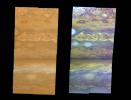
|
-
PIA03000:
-
Atmospheric Motion in Jupiter's Northern Hemisphere
Full Resolution:
TIFF
(22.55 MB)
JPEG
(540 kB)
|

|
2000-08-11 |
Europa
|
Galileo
|
Solid-State Imaging
|
3116x2652x1 |

|
-
PIA02960:
-
Folds on Europa
Full Resolution:
TIFF
(3.943 MB)
JPEG
(775.9 kB)
|

|
2000-08-03 |
Ganymede
|
Galileo
|
Solid-State Imaging
|
2133x1600x3 |

|
-
PIA01082:
-
Possible Internal Structures of the Galilean Satellites
Full Resolution:
TIFF
(4.452 MB)
JPEG
(474.8 kB)
|

|
2000-07-10 |
Europa
|
Galileo
|
Near Infrared Mapping Spectrometer
|
950x650x3 |

|
-
PIA02561:
-
Europa Impact Crater
Full Resolution:
TIFF
(904.6 kB)
JPEG
(55.73 kB)
|

|
2000-05-31 |
Io
|
Galileo
|
Near Infrared Mapping Spectrometer
|
1130x550x3 |
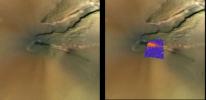
|
-
PIA02560:
-
Temperature Map of Pele, Io
Full Resolution:
TIFF
(1.376 MB)
JPEG
(57.62 kB)
|

|
2000-05-31 |
Io
|
Galileo
|
Near Infrared Mapping Spectrometer
|
850x410x1 |

|
-
PIA02559:
-
Sulphur Dioxide on the Chaac Region of Io
Full Resolution:
TIFF
(145.7 kB)
JPEG
(35.13 kB)
|

|
2000-05-31 |
Io
|
Galileo
|
Near Infrared Mapping Spectrometer
|
890x376x3 |

|
-
PIA02558:
-
Myriad of Hot Spots on Io
Full Resolution:
TIFF
(56.56 kB)
JPEG
(27.49 kB)
|

|
2000-05-31 |
Io
|
Galileo
|
Solid-State Imaging
|
618x850x1 |

|
-
PIA02557:
-
Lava Flows and Ridged Plains at Prometheus, Io
Full Resolution:
TIFF
(460.9 kB)
JPEG
(76.71 kB)
|

|
2000-05-31 |
Io
|
Galileo
|
Solid-State Imaging
|
800x600x1 |

|
-
PIA02556:
-
Highest-Resolution Picture of Io
Full Resolution:
TIFF
(471.2 kB)
JPEG
(105.6 kB)
|

|
2000-05-31 |
Io
|
Galileo
|
Solid-State Imaging
|
875x900x1 |

|
-
PIA02555:
-
Shamshu Mons and Patera, Io
Full Resolution:
TIFF
(251 kB)
JPEG
(83.46 kB)
|

|
2000-05-31 |
Io
|
Galileo
|
Solid-State Imaging
|
643x566x3 |

|
-
PIA02554:
-
Colorized View of Zal Region, Io
Full Resolution:
TIFF
(564.4 kB)
JPEG
(39.15 kB)
|

|
2000-05-31 |
Io
|
Galileo
|
Solid-State Imaging
|
506x411x3 |

|
-
PIA02553:
-
Stereo Image of Zal Patera and Neighboring Mountain, Io
Full Resolution:
TIFF
(532.5 kB)
JPEG
(23.59 kB)
|

|
2000-05-31 |
Io
|
Galileo
|
Solid-State Imaging
|
876x900x3 |

|
-
PIA02552:
-
Stereo Image of Tvashtar Catena, Io
Full Resolution:
TIFF
(1.615 MB)
JPEG
(96.08 kB)
|

|
2000-05-31 |
Io
|
Galileo
|
Solid-State Imaging
|
1152x605x1 |
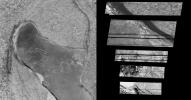
|
-
PIA02551:
-
Snapshots of Chaac: Io's Calderas Up Close
Full Resolution:
TIFF
(215.1 kB)
JPEG
(89.51 kB)
|

|
2000-05-31 |
Io
|
Galileo
|
Solid-State Imaging
|
800x800x3 |
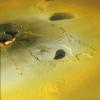
|
-
PIA02550:
-
Ongoing Volcanic Eruption at Tvashtar Catena, Io
Full Resolution:
TIFF
(2.248 MB)
JPEG
(81.64 kB)
|

|
2000-05-18 |
Io
|
Galileo
|
Near Infrared Mapping Spectrometer
|
1060x767x3 |

|
-
PIA02549:
-
Temperature Comparison at Loki
Full Resolution:
TIFF
(291.5 kB)
JPEG
(133.3 kB)
|

|
2000-05-18 |
Io
|
Galileo
|
Near Infrared Mapping Spectrometer
|
661x556x3 |

|
-
PIA02548:
-
Temperature Map of Io's Night Side
Full Resolution:
TIFF
(924.6 kB)
JPEG
(82.66 kB)
|

|
2000-05-18 |
Io
|
Galileo
|
Photopolarimeter-Radiometer
|
1225x827x3 |

|
-
PIA02547:
-
The Role of Sulfur in Io's Volcanoes
Full Resolution:
TIFF
(1.611 MB)
JPEG
(75.39 kB)
|

|
2000-05-18 |
Io
|
Galileo
|
Photopolarimeter-Radiometer
|
710x746x3 |

|
-
PIA02546:
-
Sulfur Gas in Pele's Plume
Full Resolution:
TIFF
(544.7 kB)
JPEG
(42.15 kB)
|

|
2000-05-18 |
Io
|
Galileo
|
Solid-State Imaging
|
881x778x3 |

|
-
PIA02545:
-
Eruption at Tvashtar Catena, Io, in Color
Full Resolution:
TIFF
(1.946 MB)
JPEG
(86.57 kB)
|

|
2000-05-18 |
Io
|
Galileo
|
Near Infrared Mapping Spectrometer
|
504x604x3 |

|
-
PIA02544:
-
Culann Patera/NIMS
Full Resolution:
TIFF
(478.6 kB)
JPEG
(16.82 kB)
|

|
2000-05-18 |
Io
|
Galileo
|
Near Infrared Mapping Spectrometer
|
2000x2028x3 |

|
-
PIA02543:
-
Prometheus Silicates/Sulfur dioxide/NIMS
Full Resolution:
TIFF
(4.722 MB)
JPEG
(347.4 kB)
|

|
2000-05-18 |
Io
|
Galileo
|
Near Infrared Mapping Spectrometer
|
1192x784x3 |

|
-
PIA02542:
-
Prometheus/NIMS
Full Resolution:
TIFF
(1.242 MB)
JPEG
(29.71 kB)
|

|
2000-05-18 |
Io
|
Galileo
|
Near Infrared Mapping Spectrometer
|
1000x1200x3 |

|
-
PIA02541:
-
Loki Patera/NIMS
Full Resolution:
TIFF
(639.3 kB)
JPEG
(78.9 kB)
|

|
2000-05-18 |
Io
|
Galileo
|
Solid-State Imaging
|
381x900x1 |

|
-
PIA02540:
-
Rifting at Hi'iaka Patera, Io?
Full Resolution:
TIFF
(156.2 kB)
JPEG
(61.54 kB)
|

|
2000-05-18 |
Io
|
Galileo
|
Solid-State Imaging
|
1152x491x1 |

|
-
PIA02539:
-
Bright Lava Flows at Emakong Patera, Io
Full Resolution:
TIFF
(247.5 kB)
JPEG
(105.2 kB)
|

|
2000-05-18 |
Io
|
Galileo
|
Solid-State Imaging
|
1152x443x1 |

|
-
PIA02538:
-
Changes Observed in Just 4.5 Months at Prometheus, Io
Full Resolution:
TIFF
(162.1 kB)
JPEG
(69.06 kB)
|

|
2000-05-18 |
Io
|
Galileo
|
Solid-State Imaging
|
1152x214x1 |

|
-
PIA02537:
Lava Flows at Zamama, Io
Full Resolution:
TIFF
(75.33 kB)
JPEG
(39.4 kB)
|

|
2000-05-18 |
Io
|
Galileo
|
Solid-State Imaging
|
1152x758x1 |

|
-
PIA02536:
-
1997 Lava Flows Near Pillan Patera, Io
Full Resolution:
TIFF
(366.3 kB)
JPEG
(169.6 kB)
|

|
2000-05-18 |
Io
|
Galileo
|
Solid-State Imaging
|
900x689x3 |
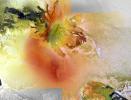
|
-
PIA02535:
-
Culann Patera, Io, in False Color
Full Resolution:
TIFF
(2.192 MB)
JPEG
(105.6 kB)
|

|
2000-04-24 |
Amalthea
|
Galileo
|
Solid-State Imaging
|
860x410x1 |

|
-
PIA02532:
-
Bright Streak on Amalthea
Full Resolution:
TIFF
(134.2 kB)
JPEG
(14.86 kB)
|

|
2000-04-24 |
Amalthea
|
Galileo
|
Solid-State Imaging
|
748x381x1 |

|
-
PIA02531:
-
Best images yet of Thebe, Amalthea and Metis
Full Resolution:
TIFF
(85.79 kB)
JPEG
(11.9 kB)
|

|
2000-04-24 |
Amalthea
|
Galileo
|
Solid-State Imaging
|
490x1190x1 |

|
-
PIA02530:
-
Jupiter Small Satellite Montage
Full Resolution:
TIFF
(138.7 kB)
JPEG
(19.02 kB)
|

|
2000-04-19 |
Io
|
Galileo
|
Solid-State Imaging
|
769x774x3 |

|
-
PIA02534:
-
Terrain near Io's South Pole, in Color
Full Resolution:
TIFF
(1.812 MB)
JPEG
(84.44 kB)
|

|
2000-04-19 |
Io
|
Galileo
|
Solid-State Imaging
|
799x739x3 |

|
-
PIA02533:
-
Highest Resolution of Lava Flows on Io
Full Resolution:
TIFF
(1.276 MB)
JPEG
(90.21 kB)
|

|
2000-04-19 |
Europa
|
Galileo
|
Near Infrared Mapping Spectrometer
|
700x600x3 |

|
-
PIA02529:
-
Europa: Sea Salts or Battery Acid
Full Resolution:
TIFF
(976.3 kB)
JPEG
(64.07 kB)
|

|
2000-03-06 |
Europa
|
Galileo
|
Solid-State Imaging
|
900x900x1 |

|
-
PIA02528:
-
Europa's Jupiter-Facing Hemisphere
Full Resolution:
TIFF
(246.1 kB)
JPEG
(126.4 kB)
|

|
2000-03-06 |
Io
|
Galileo
|
Solid-State Imaging
|
712x900x3 |

|
-
PIA02527:
-
Zal Patera, Io, in color
Full Resolution:
TIFF
(2.005 MB)
JPEG
(75.34 kB)
|

|
2000-03-06 |
Io
|
Galileo
|
Solid-State Imaging
|
1152x807x3 |

|
-
PIA02526:
-
Ionian Mountains and Calderas, in Color
Full Resolution:
TIFF
(3.203 MB)
JPEG
(170.4 kB)
|

|
1999-12-17 |
Io
|
Galileo
|
|
717x653x3 |

|
-
PIA02524:
-
Galileo PPR Temperature Maps of Loki in October 1999
Full Resolution:
TIFF
(140.3 kB)
JPEG
(61.33 kB)
|

|
1999-12-17 |
Io
|
Galileo
|
Solid-State Imaging
|
717x653x3 |

|
-
PIA02525:
-
Interpreted Lava Fountains on Io
Full Resolution:
TIFF
(1.3 MB)
JPEG
(124.8 kB)
|

|
1999-12-17 |
Io
|
Galileo
|
|
630x261x3 |

|
-
PIA02523:
-
Earth-based images of the Fall 1999 Loki Eruption
Full Resolution:
TIFF
(162.4 kB)
JPEG
(13.14 kB)
|

|
1999-12-17 |
Io
|
Galileo
|
|
688x744x3 |

|
-
PIA02522:
-
Earth-Based Observations of a Fire Fountain on Io
Full Resolution:
TIFF
(58.53 kB)
JPEG
(12.82 kB)
|

|
1999-12-17 |
Io
|
Galileo
|
Near Infrared Mapping Spectrometer
|
800x400x3 |

|
-
PIA02521:
-
Eruption from High Latitude Caldera Viewed by the Near-Infrared Mapping Spectrometer (NIMS)
Full Resolution:
TIFF
(482.4 kB)
JPEG
(46.98 kB)
|

|
1999-12-17 |
Io
|
Galileo
|
Solid-State Imaging
|
797x398x1 |

|
-
PIA02520:
-
Mountains on Io
Full Resolution:
TIFF
(267.5 kB)
JPEG
(72.92 kB)
|

|
1999-12-17 |
Io
|
Galileo
|
Solid-State Imaging
|
1152x280x1 |

|
-
PIA02519:
Lava Fountains on Io
Full Resolution:
TIFF
(139.9 kB)
JPEG
(56.66 kB)
|

|
1999-12-17 |
Io
|
Galileo
|
Solid-State Imaging
|
797x900x3 |

|
-
PIA02518:
-
Bright Channelized Lava Flows on Io
Full Resolution:
TIFF
(1.55 MB)
JPEG
(115.7 kB)
|

|
1999-12-17 |
Io
|
Galileo
|
Solid-State Imaging
|
1152x613x1 |

|
-
PIA02517:
-
Reconstruction of Scrambled Io Images
Full Resolution:
TIFF
(245.3 kB)
JPEG
(96.38 kB)
|

|
1999-11-19 |
Io
|
Galileo
|
Near Infrared Mapping Spectrometer
|
841x631x3 |

|
-
PIA02516:
-
Galileo NIMS Observes Amirani
Full Resolution:
TIFF
(274.2 kB)
JPEG
(34.6 kB)
|

|
1999-11-19 |
Io
|
Galileo
|
Near Infrared Mapping Spectrometer
|
1157x841x3 |

|
-
PIA02515:
-
Io's Prometheus Regions as Viewed by Galileo NIMS
Full Resolution:
TIFF
(870 kB)
JPEG
(76.75 kB)
|

|
1999-11-19 |
Io
|
Galileo
|
Near Infrared Mapping Spectrometer
|
1157x1241x3 |

|
-
PIA02514:
-
Loki as viewed by Galileo NIMS
Full Resolution:
TIFF
(638.9 kB)
JPEG
(92.45 kB)
|

|
1999-11-19 |
Io
|
Galileo
|
Solid-State Imaging
|
1286x1447x1 |

|
-
PIA02513:
-
Collapsing Mountains on Io
Full Resolution:
TIFF
(1.291 MB)
JPEG
(251.9 kB)
|

|
1999-11-19 |
Io
|
Galileo
|
Solid-State Imaging
|
1079x1211x3 |

|
-
PIA02512:
-
Ongoing Geologic Activity at Prometheus Volcano, Io
Full Resolution:
TIFF
(1.409 MB)
JPEG
(94.2 kB)
|

|
1999-11-19 |
Io
|
Galileo
|
Solid-State Imaging
|
682x970x3 |

|
-
PIA02511:
-
Pele's Hot Caldera Margin
Full Resolution:
TIFF
(290.8 kB)
JPEG
(44.06 kB)
|

|
1999-11-19 |
Io
|
Galileo
|
Solid-State Imaging
|
1114x567x3 |

|
-
PIA02510:
-
Pele's Glow
Full Resolution:
TIFF
(1.391 MB)
JPEG
(42.92 kB)
|

|
1999-11-04 |
Io
|
Galileo
|
Near Infrared Mapping Spectrometer
|
959x581x3 |

|
-
PIA02509:
-
Galileo's Near-Infrared Mapping Spectrometer Detects Active Lava Flows at Prometheus Volcano, Io
Full Resolution:
TIFF
(67.96 kB)
JPEG
(35 kB)
|

|
1999-11-04 |
Io
|
Galileo
|
Solid-State Imaging
|
1969x1684x3 |

|
-
PIA02508:
-
Galileo Discovers Caldera at Prometheus Volcano, Io
Full Resolution:
TIFF
(5.342 MB)
JPEG
(193.5 kB)
|

|
1999-10-25 |
Io
|
Galileo
|
Solid-State Imaging
|
797x240x1 |

|
-
PIA02507:
-
Highest Resolution Image Ever Obtained of Io
Full Resolution:
TIFF
(227.4 kB)
JPEG
(51.2 kB)
|

|
1999-10-08 |
Io
|
Galileo
|
Solid-State Imaging
|
336x436x3 |

|
-
PIA02506:
-
Amirani-Maui: Longest Known Active Lava Flow in the Solar System
Full Resolution:
TIFF
(392.2 kB)
JPEG
(21.24 kB)
|

|
1999-10-08 |
Io
|
Galileo
|
Solid-State Imaging
|
398x398x3 |

|
-
PIA02505:
-
Close-up of Prometheus, Io (color)
Full Resolution:
TIFF
(360.9 kB)
JPEG
(17.74 kB)
|

|
1999-10-08 |
Io
|
Galileo
|
Solid-State Imaging
|
967x395x3 |

|
-
PIA02504:
-
Close-up of Zamama, Io (Color)
Full Resolution:
TIFF
(948.9 kB)
JPEG
(32.3 kB)
|

|
1999-10-08 |
Io
|
Galileo
|
Solid-State Imaging
|
879x202x1 |

|
-
PIA02503:
Migrating Volcanic Plumes on Io
Full Resolution:
TIFF
(122.8 kB)
JPEG
(21.5 kB)
|

|
1999-10-08 |
Io
|
Galileo
|
Solid-State Imaging
|
329x431x3 |

|
-
PIA02502:
-
Masubi Plume on Io
Full Resolution:
TIFF
(289.4 kB)
JPEG
(14 kB)
|

|
1999-10-08 |
Io
|
Galileo
|
Solid-State Imaging
|
1040x349x3 |

|
-
PIA02501:
-
Changes at Pillan Patera
Full Resolution:
TIFF
(1.087 MB)
JPEG
(39.87 kB)
|

|
1999-10-07 |
Callisto
|
Galileo
|
Solid-State Imaging
|
1440x669x1 |

|
-
PIA01656:
-
Europa, Ganymede, and Callisto: Surface Comparison at High Spatial Resolution
Full Resolution:
TIFF
(1.017 MB)
JPEG
(271.6 kB)
|

|
1999-10-07 |
Ganymede
|
Galileo
|
Solid-State Imaging
|
610x900x1 |

|
-
PIA01660:
-
Pedestal Craters Gula and Achelous on Ganymede
Full Resolution:
TIFF
(290 kB)
JPEG
(126.9 kB)
|

|
1999-10-07 |
Ganymede
|
Galileo
|
Solid-State Imaging
|
1078x900x1 |

|
-
PIA01659:
-
Buto Facula - A Palimpsest on Ganymede
Full Resolution:
TIFF
(412.8 kB)
JPEG
(264.9 kB)
|

|
1999-10-07 |
Ganymede
|
Galileo
|
Solid-State Imaging
|
590x900x1 |

|
-
PIA01658:
-
Dome Crater Neith on Jupiter's Satellite Ganymede
Full Resolution:
TIFF
(642.1 kB)
JPEG
(193.4 kB)
|

|
1999-10-07 |
Callisto
|
Galileo
|
Solid-State Imaging
|
449x449x1 |

|
-
PIA01657:
-
Crater Tindr on Callisto - an Oblique Impact?
Full Resolution:
TIFF
(157 kB)
JPEG
(67.49 kB)
|

|
1999-09-30 |
Europa
|
Galileo
|
Near Infrared Mapping Spectrometer
|
837x796x3 |

|
-
PIA02500:
-
Sulfuric Acid on Europa
Full Resolution:
TIFF
(1.208 MB)
JPEG
(55.43 kB)
|

|
1999-09-27 |
Jupiter
|
Galileo
|
Solid-State Imaging
|
1200x700x1 |

|
-
PIA00829:
-
Mosaic of Jupiter's Great Red Spot (in the near infrared)
Full Resolution:
TIFF
(373.9 kB)
JPEG
(75.8 kB)
|

|
1999-08-27 |
Io
|
Galileo
|
Solid-State Imaging
|
2000x1380x3 |
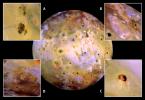
|
-
PIA02319:
-
Closeups of Io (false color)
Full Resolution:
TIFF
(6.806 MB)
JPEG
(301 kB)
|

|
1999-08-27 |
Io
|
Galileo
|
Solid-State Imaging
|
2796x2796x3 |
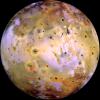
|
-
PIA02309:
-
Global image of Io (false color)
Full Resolution:
TIFF
(17.09 MB)
JPEG
(908.3 kB)
|

|
1999-08-27 |
Io
|
Galileo
|
Solid-State Imaging
|
2796x2796x3 |

|
-
PIA02308:
-
Global image of Io (true color)
Full Resolution:
TIFF
(17.28 MB)
JPEG
(789.8 kB)
|

|
1999-08-27 |
Europa
|
Galileo
|
Solid-State Imaging
|
2530x1327x3 |

|
-
PIA02099:
-
Thera and Thrace on Europa
Full Resolution:
TIFF
(7.171 MB)
JPEG
(544.1 kB)
|

|
1999-08-27 |
Jupiter
|
Galileo
|
Solid-State Imaging
|
2200x1200x3 |

|
-
PIA02098:
-
Clouds and Hazes of Jupiter's Southern Hemisphere
Full Resolution:
TIFF
(3.798 MB)
JPEG
(163.1 kB)
|

|
1999-08-27 |
Jupiter
|
Galileo
|
Solid-State Imaging
|
1300x1200x3 |

|
-
PIA02097:
-
Cloud Features North of Jupiter's Equator
Full Resolution:
TIFF
(2.356 MB)
JPEG
(87.9 kB)
|

|
1999-04-15 |
Jupiter
|
Galileo
|
Solid-State Imaging
|
640x485x1 |

|
-
PIA01655:
-
Dynamics of Jupiter's Long-lived White Ovals

Full Resolution:
|

|
1999-03-18 |
Jupiter
|
Galileo
|
Solid-State Imaging
|
640x485x1 |

|
-
PIA01651:
-
Dynamics after Historic Merger of Storms on Jupiter

Full Resolution:
|

|
1999-01-18 |
Europa
|
Galileo
|
Solid-State Imaging
|
1192x1636x3 |

|
-
PIA01669:
-
Model of Europa's Subsurface Structure
Full Resolution:
TIFF
(1.953 MB)
JPEG
(174 kB)
|

|
1999-01-18 |
Io
|
Galileo
|
Solid-State Imaging
|
708x526x3 |

|
-
PIA01668:
-
Key Volcanic Centers on Io
Full Resolution:
TIFF
(884.3 kB)
JPEG
(56.36 kB)
|

|
1999-01-18 |
Io
|
Galileo
|
Solid-State Imaging
|
800x800x3 |

|
-
PIA01667:
-
Io's Pele Hemisphere After Pillan Changes
Full Resolution:
TIFF
(1.347 MB)
JPEG
(56.68 kB)
|

|
1999-01-18 |
Ganymede
|
Galileo
|
Solid-State Imaging
|
687x687x3 |

|
-
PIA01666:
-
Ganymede's Trailing Hemisphere
Full Resolution:
TIFF
(847.8 kB)
JPEG
(47.68 kB)
|

|
1999-01-18 |
Europa
|
Galileo
|
Solid-State Imaging
|
1050x520x3 |

|
-
PIA01665:
-
Red-Blue Three Dimensional View of Pwyll crater
Full Resolution:
TIFF
(1.248 MB)
JPEG
(152 kB)
|

|
1999-01-18 |
Europa
|
Galileo
|
Solid-State Imaging
|
1152x696x3 |

|
-
PIA01664:
-
Three Dimensional View of Double Ridges on Europa
Full Resolution:
TIFF
(955 kB)
JPEG
(152.7 kB)
|

|
1999-01-18 |
Io
|
Galileo
|
Solid-State Imaging
|
1152x614x1 |

|
-
PIA01663:
-
Highest Resolution Mosaic of Io
Full Resolution:
TIFF
(247.9 kB)
JPEG
(126.2 kB)
|

|
1999-01-18 |
Europa
|
Galileo
|
Solid-State Imaging
|
700x540x1 |

|
-
PIA01662:
-
Topography Around Europa's Cilix Crater
Full Resolution:
TIFF
(158.3 kB)
JPEG
(76.28 kB)
|

|
1999-01-18 |
Europa
|
Galileo
|
Solid-State Imaging
|
988x900x1 |

|
-
PIA01661:
-
Large Impact Structures on Europa
Full Resolution:
TIFF
(509.8 kB)
JPEG
(272.6 kB)
|

|
1998-12-07 |
Jupiter
|
Galileo
|
Photopolarimeter-Radiometer
|
1500x2571x3 |

|
-
PIA01496:
-
Jovian Dark Spot
Full Resolution:
TIFF
(2.798 MB)
JPEG
(143.5 kB)
|

|
1998-12-07 |
Europa
|
Galileo
|
Solid-State Imaging
|
1152x626x3 |

|
-
PIA01654:
-
Rugged Terrain on Europa in 3-D Stereo
Full Resolution:
TIFF
(1.106 MB)
JPEG
(117.9 kB)
|

|
1998-12-07 |
Europa
|
Galileo
|
Solid-State Imaging
|
2476x1988x1 |
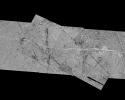
|
-
PIA01653:
-
Rugged Terrain on Europa
Full Resolution:
TIFF
(2.31 MB)
JPEG
(433.8 kB)
|

|
1998-12-07 |
Io
|
Galileo
|
Solid-State Imaging
|
1152x887x3 |

|
-
PIA01652:
-
Sequence Showing Active Volcanic Plumes on Io
Full Resolution:
TIFF
(2.093 MB)
JPEG
(73 kB)
|

|
1998-12-07 |
Jupiter
|
Galileo
|
Solid-State Imaging
|
900x900x3 |

|
-
PIA01650:
-
Historic Merger of Storms on Jupiter
Full Resolution:
TIFF
(1.153 MB)
JPEG
(75.13 kB)
|

|
1998-12-07 |
Callisto
|
Galileo
|
Solid-State Imaging
|
1152x884x3 |

|
-
PIA01649:
-
The Valhalla Multi-ring Structure on Callisto
Full Resolution:
TIFF
(1.477 MB)
JPEG
(175.5 kB)
|

|
1998-12-07 |
Callisto
|
Galileo
|
Solid-State Imaging
|
1152x884x3 |

|
-
PIA01648:
-
Impact Craters on Icy Callisto: Doh Crater and Asgard
Full Resolution:
TIFF
(1.689 MB)
JPEG
(218.7 kB)
|

|
1998-12-07 |
Europa
|
Galileo
|
Solid-State Imaging
|
1152x507x3 |

|
-
PIA01647:
-
Agenor Linea in Color
Full Resolution:
TIFF
(1.409 MB)
JPEG
(113.3 kB)
|

|
1998-12-07 |
Europa
|
Galileo
|
Solid-State Imaging
|
1152x830x1 |

|
-
PIA01646:
-
Agenor Linea at High Resolution
Full Resolution:
TIFF
(447.2 kB)
JPEG
(214.3 kB)
|

|
1998-12-07 |
Europa
|
Galileo
|
Solid-State Imaging
|
1231x558x3 |
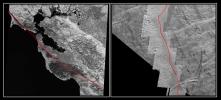
|
-
PIA01645:
-
The San Andreas Fault and a Strike-slip Fault on Europa
Full Resolution:
TIFF
(504.9 kB)
JPEG
(134.7 kB)
|

|
1998-12-07 |
Europa
|
Galileo
|
Solid-State Imaging
|
678x900x1 |

|
-
PIA01644:
-
San Andreas-sized Strike-slip Fault on Europa
Full Resolution:
TIFF
(177.9 kB)
JPEG
(106 kB)
|

 Planetary Data System
Planetary Data System



















































































































